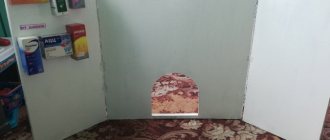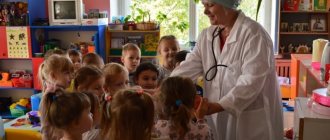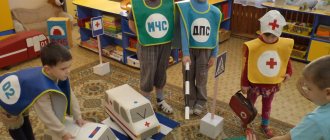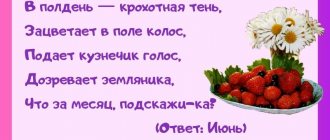Thematic role-playing game “Space” for children of the middle group
The plot-role-playing game “Space” for children of middle preschool age.
Author: Vereshchagina Oksana Viktorovna, teacher Municipal Budgetary Preschool Educational Institution, combined kindergarten No. 58, Apatity, Murmansk region. Description of the material: I offer a summary of a plot-role-playing game for children in the middle group. This material will be useful for middle school teachers. This is a summary of a plot-based role-playing game aimed at developing gaming skills, abilities and curiosity in children of middle preschool age, and at cultivating an interest in space.
Summary of the plot-role-playing game “Space” for children of middle preschool age.
Integration of educational areas: “Cognition”, “Communication”, “Socialization”, “Artistic creativity”. Goal : to introduce children to a new role-playing game. Objectives: - learn to combine several plots into one; - learn to play together; - introduce space-related professions. Vocabulary: space, astronauts, cosmodrome, spaceship, mission control center, head of the mission control center, cosmonaut training center, medical center, flight engineer, programmer, reporter photographer, meteor shower. Materials for the game: badges with inscriptions (“1 pilot”, “2 pilot”, “head of the mission control center”, “spacecraft commander”, “doctor”, “flight engineer”, “programmer”, “photographer-reporter”), riddles on the topic Space, saucer, lid, tambourine, circle, dummies (banana, carrot, apple, plum), briefcases (optional) for medical and working instruments, medical instruments (stethoscope, thermometer, etc.), working tools (pincers , hammer, etc.), computer keyboard, magnifying glass, camera, “meteor shower” (sheets of paper crumpled into balls), large construction set, chairs according to the number of children Preliminary work: teacher’s story about the first flight into space and the first cosmonaut Yuri Alekseevich Gagarin ;
reading fiction on the topic of the game, looking at illustrations on the topic “Space”. Progress of the game:
Educator: Hello, children! Today we will play a new game with you. It's called Space. We talked a lot about space and the first cosmonaut. Today we will need your knowledge. Where do you think space launches take place? Children: They take place at the cosmodrome. Educator: Correct. Who is the main person at the cosmodrome? Children: Astronauts. Educator: Let me give you a hint. He is called the head of the flight control center. What is the name of this profession? Children: She is called the head of the mission control center. Educator: Well done! Today our leader will be Tatyana Viktorovna. She will guide our flight. What other professions do you think there are still at the cosmodrome?
Children: Space flights also require astronauts, doctors, and builders. Educator: That's right. For the duration of our game, I will be the commander of the spaceship. We also need two pilots. What will be the opinions? Who will we appoint as pilots? Children: (propose candidates) Educator: We settled on the fact that Dima is the first pilot, and Oleg is the second pilot. We will also have a medical center and repair shops. Who wants to be a doctor on a spaceship? Children: (propose candidates) Educator: Okay. Let Vika be the doctor. We also need a programmer and a photographer/reporter. We need a programmer to enter data into the computer. And why do we need a photographer/reporter? Children: A photographer is needed to photograph everything and then tell it in a newspaper or magazine. Educator: That's right. Who wants to be a programmer? Children: (propose candidates). Educator: Okay. Katya will become a programmer for the duration of our flight. Who do we trust to take photographs? Children: (propose candidates). Educator: Excellent choice. Arina will be a photographer/reporter for the duration of the flight. Who wants to be a flight engineer? Children: (propose candidates) Educator: We will choose Andrey as the flight engineer. That's agreed. Now tell me, please, what do you think astronauts should be like? Children: They must be brave, strong, strong. Educator: Should they be smart? After all, not all people can become astronauts. There is so much they need to know. Children: And astronauts must be smart. Educator: Where are astronauts trained? Who knows? Children: They are trained at the school for astronauts. Educator: Not exactly. Cosmonauts undergo training at the Cosmonaut Training Center. Well, since you and I are also cosmonauts today, please imagine that we are in such a center and are undergoing training there. We have a task for you to learn about space objects. Please guess my riddles. The very first in space Flew at great speed Brave Russian guy Our cosmonaut... Children: Gagarin. Educator: Correct. On an airship, spaceship, obedient, We, overtaking the wind, are rushing on... Children: Rocket. Educator: That's right. A fragment from the planet Among the stars is rushing somewhere. He has been flying for many years - flying, Space... Children: Meteorite. Educator: Well done! The planet is blue, Beloved, dear, It is yours, it is mine, And it is called... Children: Earth. Educator: Lights up the way at night, Keeps the stars from falling asleep. Let everyone sleep, she has no time for sleep, There is light in the sky for us... Children: The moon.
Educator: Well done! Next task. Please look at this table and tell me what is unnecessary here and why. (There are replicas of a banana, an apple, a carrot and a plum on the table) Children: There is an extra carrot here. This is a vegetable, and everything else is fruit.
Educator: Here is the next task, for intelligence. Please look at these items and tell me what they have in common. (There is a saucer, a lid, a circle, a tambourine on the table).
Children: These objects are round. Educator: Well done! Well, you and I are also convinced that intellectually we all correspond to this profession. Do you think astronauts should be dexterous? Children: Yes. Educator: Let's show you that we are also dexterous. (Physical minute) Children: (perform exercises with the teacher) Educator: And now our head of the flight control center will give you a task. Head of the flight control center: You are going to the medical center, where our doctor Vika will check if everyone is healthy.
Educator: Vika, let me help you put on a medical gown (helps). And we all, one by one, approach our doctor for examination. Children: (approach the doctor who listens to them with a stethoscope)
Educator: Doctor, please tell us, is everyone healthy? Doctor: Yes, everyone is healthy. Educator: Can everyone fly into space? Doctor: Everyone can fly. Children: (rejoice). Educator: Doctor, please select all the medical instruments necessary for a flight into space. Of course you are flying with us. Doctor: (selects medical instruments).
Educator: And now we are going to the repair shops, where our technician-designer will also select the rockets necessary for repair and construction. Technician - designer: (selects tools).
Educator: The most crucial moment. Our design technician will build the rocket with our help. Let's help him. Children: (start building a rocket). Educator: Well, our rocket is ready to fly. But we won’t fit all at once. Let's use a counting rhyme to choose the flight order.
Children: (determine the order). Educator: The rocket hatch opens. Please take your seats. First pilot. Second pilot. Doctor. Technician - designer. Photographer - reporter. Programmer.
Children: (walk with their chairs, take their places)
Educator: So, the first space expedition of the middle group sets off on a flight to the moon. The head of the flight control center begins the countdown. Head of Mission Control Center: Five, four, three, two, one! Start! Educator: Here we are in space. Look how beautiful our land is from above. All in a blue glow. We are approaching the moon. Attention, we are starting to board. First pilot, start the countdown.
1 pilot: Five, four... Educator: We landed. How carefully our pilots landed the rocket! Real professionals! The hatch opens. We reach the surface of the moon. While you and I are inspecting the surface of the Moon, our design technician will check the condition of the rocket. Design technician: (checks the condition of the rocket, taps with a hammer, inspects its body) Children: (go out and walk around the rocket)
Educator: And our photographer-reporter and programmer will take photographs of the surface of the moon and enter the data into the computer. Programmer and photographer - reporter: (walk with a magnifying glass and a camera, examine, “take photographs,” “enter data into the computer”) Educator: What is this approaching the Moon and our spaceship? Attention! Danger! Meteor Rain! We all go into the rocket. “Children remaining on Earth”: (Throwing “meteorites” towards the rocket). Educator: Did everyone manage to take refuge in the rocket? Children: Yes, we all made it. Educator: Pilots, start taking off! Pilots: Five, four... Educator: We are returning to Earth.
Children: (express joy). Educator: Well, you and I have visited the Moon. Did you like the new game? Children: Yes, I liked it.
Educator: The second group of astronauts begins to prepare for the flight...
We recommend watching:
Summary of a plot-role-playing game for the middle group “Hospital” An entertainment game for children of the middle group. A plot-role-playing game for children of the middle group: Toy Store. Plot-role-playing games for kindergarten with goals. Card index
Similar articles:
Game "Cabbage" for older children
Games for middle school children in kindergarten
Developmental tasks on logic for children 4-5 years old
Attention tasks for children 4-5 years old in pictures
Cosmonautics Day in kindergarten. Middle group
My kindergarten
Tasks:
1. Improve children’s ability to negotiate a game.
2. Develop the ability to coordinate your actions with the actions of your partners, observe role relationships, and obey the rules.
3. Strengthen the ability to complicate the game by expanding the composition of roles, increasing the number of combined storylines.
4. Develop speech skills: monologue speech (TV news announcer, chief designer, flight training instructor), dialogic speech (role-playing dialogues of all participants in the game). Activate the vocabulary using the words: cosmodrome, spacesuit, chief designer, solar system, planets, meteorites, comets, milky way, constellations, cosmic dust; words - names of planets, etc.
5. Strengthen the ability to use a variety of non-verbal means of communication in the game: facial expressions, gestures, actions.
6. Develop creative imagination in play, creative initiative. Encourage the desire to come up with new themes for the game. Encourage the use of substitute items and attributes made with your own hands.
7. Cultivate friendly relationships between children in the group, the ability to negotiate, and calmly resolve conflicts. Develop the ability to be on the same team, empathize and rejoice, and solve problems together.
Preliminary work:
- Reading: the story of V. Borozdin “First in Space”, G. Shalaev “Why don’t planets collide?”, “What is a comet?”, “Why does a comet have a tail?”, “Is it far from the stars?”, “Once upon a time was an astrologer." Review of the album “Yu. A. Gagarin”, “Pilots-Cosmonauts of the USSR”.
- Reading encyclopedic information on space flights, space technology, cosmic bodies (“Entertaining atlas: science and discoveries, inventions”, “Preschooler’s Encyclopedia”)
- Examination of images of planets, constellations, a model of the solar system, illustrations and books on the topic “Space”.
- Speech development: “This mysterious space”
- Presentation "This amazing space."
- Observations on a walk of the sky, stars in the dark, the Moon: new moon, month, half moon, full moon.
- Experiment with a globe and a lamp “Day and Night”.
- Memorizing poems about space, solving riddles.
- Application: “Rocket”, “Starry Sky”.
- Construction: “Spaceships”, “Cosmodrome”.
- Crafts and drawings on the theme “Mysterious Space”.
- Making a collage “Aliens from Outer Space”.
- Ri.
Attraction "Space Junk". Relay race “Colorful planets”.
- Watching the cartoon “The Secret of the Third Planet”
- Making attributes for the game (rocket, food for astronauts, instrument panel, control center)
- Working with parents: involving them in making costumes for role-playing games.
Attributes : stencils, rulers, patterns, pencils, paper, spacesuits, rocket, large building material for creating a cosmodrome, technical equipment (walkie-talkies, computers, telephones, remote controls, etc.), space food in tubes and bags, star map , planets, reference pictures, a collection of stones, containers for collected material, microscopes, magnifying glasses, a microphone (you can use a marker), substitute items at the request of the children, etc.
Distribution of roles in the game.
1. Choice of children, by agreement, in turn (today you, tomorrow me) 2. By lot (pulling a piece of paper with the role written on it). 3. By counting. 4. By solving riddles.
Plot development.
Children can agree in advance which storyline they choose this time. And schematically, with the help of reference pictures, on a flannelgraph, lay out the course of the game. Or they can immediately offer and portray a new hero or a new storyline.
- Science and Space Center. Design department. Designers are drawing diagrams of spaceships.
- Construction of a spaceship.
- Meeting of the Space Flight Commission at the Mission Control Center (selection of a task for the astronauts) Decision: which planet they will fly to. For what? Set goals and objectives.
- Training of a corps of cosmonauts. Briefing. What and how to collect in the universe (cosmic dust, minerals from other planets, space, etc.)? What is important to research?
- Training of a corps of cosmonauts. Training: how to behave with aliens.
- Physical training of the cosmonaut corps: on the “centrifuge” simulator (computer chair), exercises: wushu, general development, etc.
- Medical examination of astronauts.
- Loading everything you need onto the ship.
- Rocket launch.
- Connection with the Earth. Flight control center.
- Spacewalk, work in orbit (or on the intended planet): collection of cosmic dust, soil, space debris.
- An astronaut-artist makes sketches of outer space and takes photographs.
- The illness of one cosmonaut, his treatment.
- Landing on an unknown planet (collection of living objects: plants and animals).
- Meeting with aliens.
- Doctors examine aliens.
- Emergency on the ship (fire or failure of a rocket part).
- Communication with the Earth, with the Mission Control Center. Making the right decision.
- Repair. Extinguishing. Emergency elimination.
- Docking of ships.
- Landing (joyful meeting of astronauts, concert, medical examination, rest)
- Study of delivered soils and special objects. laboratories.
- Television, a correspondent's report, a conference with astronauts.
- Meeting of the Space Flight Commission at the Mission Control Center, debriefing.
Game actions for each role:
- Designers: draw rocket diagrams, prove why his invention should be brought to life, and build just such a spaceship. Further, they can play the roles of relatives of astronauts, laboratory assistants or aliens.
- Chief designer: selects the best invention, justifies his choice, then gets in touch with the astronauts at the Flight Control Center.
- The captain of the ship - recruits the crew, gives orders on board, keeps in touch with the flight instructor, communicates with reporters.
- Cosmonauts fly into space, follow the orders of the ship’s captain, can communicate and help aliens, communicate with Earth, and participate in a conference.
- Flight engineer: carefully monitors the flight control and docking instrument readings.
- Flight instructor - directs the flight from the Control Center.
- Aliens: observe the actions of the astronauts, come into contact with them, negotiate with gestures, facial expressions, in an incomprehensible language, they can ask for help, together with the astronauts.
- Reporters: report, communicate with astronauts, participate in the conference.
- Doctors, nurses: provide medical care. examination of the ship's crew and aliens.
- Relatives: see off and greet the astronauts, organize a concert, participate in reporting.
- Food preparation specialist: packages in bags, packs in tubes, monitors the nutrition of astronauts on the spaceship.
*Children play “Cosmos” with great desire. And the game is always different! After all, guys travel to different planets. And besides them, in the universe: asteroids, comets, meteorites... So many interesting things known and unknown! This is where there is room for children's imagination! Play with your children and you will have a lot of fun!
We play
Author: Tatyana Sergeevna Disnenko , teacher, compensatory kindergarten N26, Krasnoselsky district of St. Petersburg.





